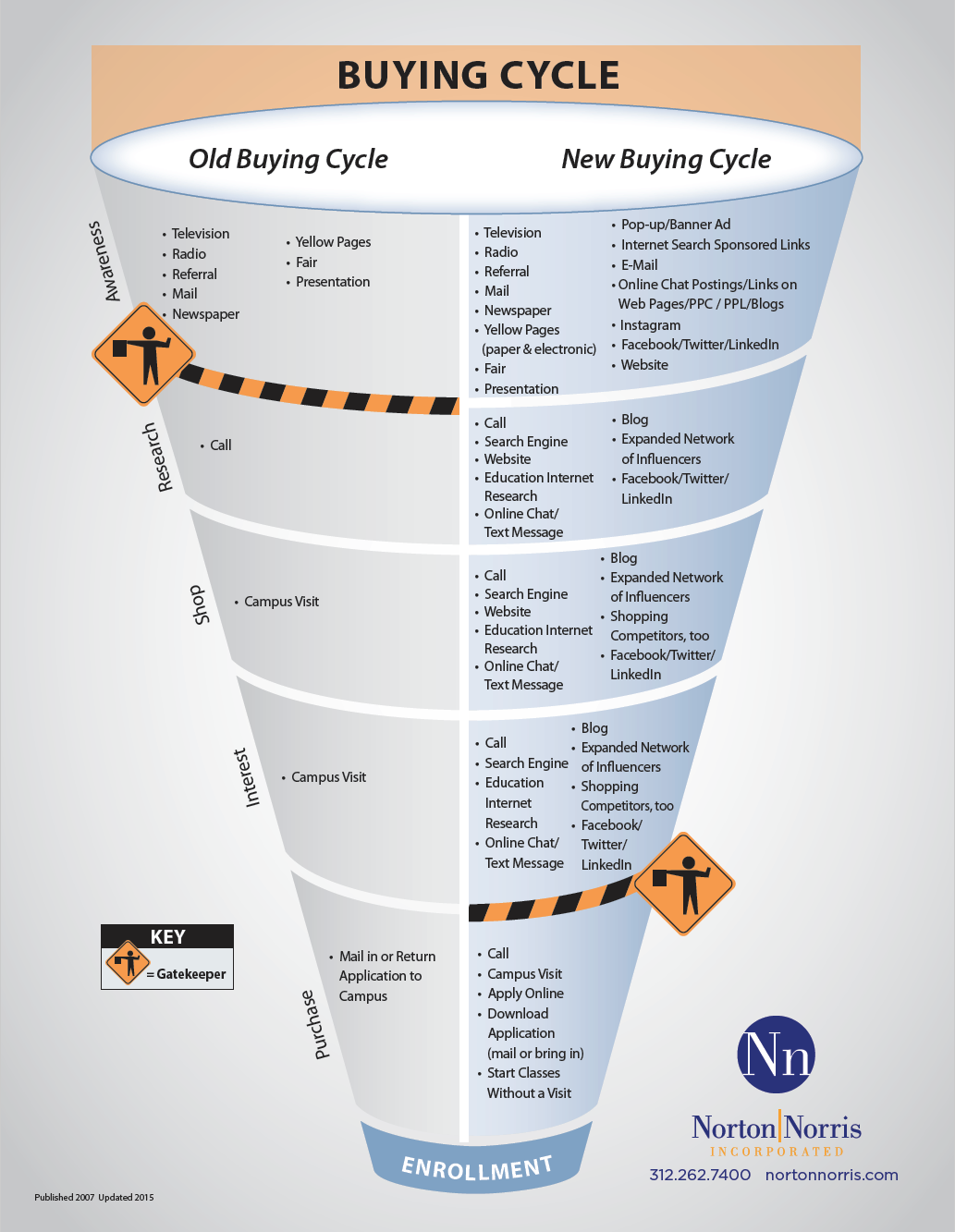Published on
Mapping the Enrollment Pipeline of Today’s Community College Customers

Vincent Norton and Jean Norris will be diving deeper into this topic at the 50th Annual NCCET Conference in Orlando, running December 10-13. To register, click here.
It’s essential for leaders of any organization to be aware of the consumer experience if they want to create value and improve results. Let’s face it, today’s consumer can move through the buying cycle without ever speaking with a person. This has interesting implications for the enrollment funnel, which was created before the invention of the Internet and mobile devices (see Buying Cycle Diagram 1).

The Harvard Business Review asked leading marketers from Google, Intuit, Sephora, Twitter and Visa if the sales funnel was still relevant. The response was a resounding, “No!”
They realized the consumer experience is much more linear, with opportunities to engage (or lose) potential customers along the way. In other words, the consumer has more control and is influenced by factors that may feel out of our control. Meaningful and timely engagement is essential to build trust and value.
We have the opportunity to learn from other consumer-driven organizations to serve our prospective students to a higher degree. This becomes crucial for higher education when the value of college is questioned and competition for students heats up.
Drop-Off Points for the Modern Learner
A prospective learner can make a decision about your college in a matter of seconds. If your website loads too slowly, isn’t mobile friendly, or doesn’t have the right information readily available, they are on to the next search in an instant. In addition, today’s consumer also expects customization and 24/7 access at the touch of a button.
We also find a lack of variety and flexibility in the early stages of the enrollment process can cause frustration. Our mystery shopping team—posing as prospective students—has encountered this. For instance, they have been directed to find information on a website when they wanted to speak with someone, watch a video, or come in for a visit instead.
We often say, “You will only get the people who buy the way you sell.” So if your institution only has one way of doing something, you’re only getting people who want to buy that way.
There is also a huge opportunity in nurturing your database of prospects. Keep in mind that people are in the buying cycle and just because they haven’t made a decision today doesn’t mean they aren’t interested. They could just be in the shopping or research stage of the process.
Five Tips to Turn Your Website Into an Enrollment Engine
Ideally, you would use landing pages for specialty programs to capture key data before sending anyone over to your website. But if that is not possible, then think of your website as a front door to your institution for the prospective student. This will take support from the very top. Too many college websites are created with current students and faculty in mind. While important, your internal stakeholders are really secondary to your new prospective students if you intend to be in growth mode.
Replacing the Sales Funnel with the Sales Flywheel introduces the power of momentum as the missing link. When marketing is done right, you will grow your followers, advocates and customers month after month. But how do you do that? Here are a few tips:
Tip One: Focus
Don’t try and be everything to everybody. Focus on your target prospects and give them a variety of clear and compelling calls to action (CTAs). One of the best CTAs is to complete an application for admission. But wait. Your application is probably long and cumbersome. So…
Tip Two: Embrace a Two-Part Application
Part one gathers basic contact information and saves it so if the prospect doesn’t complete everything, you at least have the contact information of someone who is very interested.
Tip Three: Go Mobile
Your prospects aren’t searching on a desktop, laptop or tablet. Any user experience studies (UX) and user interface (UI) decisions must be approached from a handheld mobile phone. Period.
Tip Four: Use Video
Liberally. And transcribe those videos to help you with the next tip.
Tip Five: Embrace Search Engine Optimization (SEO)
Monitor your organic web inquiries and hold someone accountable for increasing this most precious source of new students. Load time is becoming more and more important. And if you don’t post one blog a week you are missing the boat. Blogs increase your site authority and help you rank for key words. They will be long and boring. That’s OK. Google will love them.
Roadblocks to Highly Effective Websites for Community Colleges
Many community and technical colleges face a few central challenges when trying to transform their websites into enrollment engines.
To start, community colleges don’t invest in a strategic Pay Per Click (PPC) campaign. This is the first mistake. And for those colleges that are using PPC campaigns, many point the traffic to the website. This is an even bigger mistake. PPC traffic must be sent to a landing page that is designed for one purpose: To capture information or an inquiry. Sending traffic to your website gives the prospect too many options. They may end up confused and start navigating to the financial aid page, or start looking at other programs. You can let the prospect visit the primary website after they complete an inquiry form on the landing page.
Why run PPC? Good question. Do a quick search on Google. Lets say your CC is in DuPage County. So search on “DuPage County Welding Training Programs.” In this case the search yields great organic results, but the user then goes to the website, with no CTA. So there is no way to complete an inquiry form and you are counting on your prospect to call the college—and we know that making phone calls isn’t a primary mode of communication for our prospects these days.
Finally, by far the biggest roadblock is the internal politics of the institution and who “owns” the website. Chances are it’s not admissions or marketing. Many websites are controlled by IT—and handcuffed by forms that are connected to a CRM causing “friction” for the user. So decisions aren’t made with the question of UX in mind—decisions are instead made by what the “system” can accommodate.
Vincent Norton and Jean Norris will be diving deeper into this topic at the 50th Annual NCCET Conference in Orlando, running December 10-13. To register, click here.
– – – –
References
Marketing Can No Longer Rely on the Funnel, Bonchek, M. & France, C., 2014, Harvard Business Review.
Replacing the Sales Funnel with the Sales Flywheel, Halligna, B., 2018, Harvard Business Review.
The Student Buying Cycle. Norris, J. (2007/2015).
Author Perspective: Community College
Author Perspective: Business



